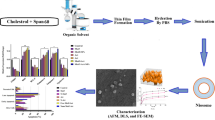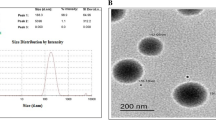Abstract
Purpose
Pancreatic cancer (PC) is predicted to become the second leading cause of cancer associated deaths by 2020. Earlier, we confirmed the development and efficacy of our novel Loratadine Self-Microemulsifying-Drug-Delivery-System - Sulforaphane (LOR SMEDDS -SFN) nanoformulation in PC chemoprevention. In this report, we extend our studies to evaluate the PC chemoprevention efficacy of LOR SMEDDS – SFN.
Methods
The nanoformulation was subjected to in vitro colony formation assays, in vivo oral pharmacokinetics and stability studies.
Results
The colony formation assay using Panc–1 PC cells demonstrated a survival fraction of 0.74 with LOR-SFN (p < 0.001) which further reduced to 0.35 with LOR SMEDDS-SFN treatment (p < 0.0001) confirming the synergistic chemoprevention efficacy of the nanoformulation. Further, the oral pharmacokinetic studies of LOR SMEDDS-SFN showed 4-fold and 9-fold increase in Cmax (503.2 ± 5.8 ng/mL) and oral bioavailability (20,274.8 ± 3711.0 ng·h/mL) for LOR compared to LOR-SFN combination respectively assuring the enhanced performance by the SMEDDS. Additionally, the formulation exhibited statistically non-significant alteration in globule size, zeta potential, drug content and in vitro drug release during stability studies confirming its stability and pharmaceutical acceptability.
Conclusion
Our studies have demonstrated a potential of LOR SMEDDS-SFN nanoformulation as an effective PC chemoprevention strategy.






Similar content being viewed by others
References
AmericanCancerSociety. Key Statistics for Pancreatic Cancer 2019 [updated 8/8/2019. Available from: https://www.cancer.org/cancer/pancreatic-cancer/about/key-statistics.html.
CancerNet. Pancreatic Cancer: Statistics 2019 [Available from: https://www.cancer.net/cancer-types/pancreatic-cancer/statistics.
ROSENZWEIG A. Increase in Pancreatic Cancer Diagnoses Expected in 2019 2019 [Available from: https://www.pancan.org/news/increase-in-pancreatic-cancer-diagnoses-expected-in-2019/.
AmericanCancerSociety. Survival Rates for Pancreatic Cancer 2019 [Available from: https://www.cancer.org/cancer/pancreatic-cancer/detection-diagnosis-staging/survival-rates.html.
NationalCancerInstitute. Cancer Stat Facts: Pancreatic Cancer 2019 [Available from: https://seer.cancer.gov/statfacts/html/pancreas.html.
Benzel J, Fendrich V. Chemoprevention and treatment of pancreatic cancer: update and review of the literature. Digestion. 2018;97(4):275–87.
Desai P, Ann D, Wang J, Prabhu S. Pancreatic cancer: recent advances in nanoformulation-based therapies. Crit Rev Ther Drug Carrier Syst. 2019;36(1):59–91.
Desai P, Thakkar A, Ann D, Wang J, Prabhu S. Loratadine self-microemulsifying drug delivery systems (SMEDDS) in combination with sulforaphane for the synergistic chemoprevention of pancreatic cancer. Drug Deliv Transl Res. 2019;9(3):641–51.
Grandhi BK, Thakkar A, Wang J, Prabhu S. A novel combinatorial nanotechnology-based oral chemopreventive regimen demonstrates significant suppression of pancreatic cancer neoplastic lesions. Cancer Prev Res (Phila). 2013;6(10):1015–25.
Bosland MC. How to rationally identify promising cancer chemoprevention agents. JNCI: Journal of the National Cancer Institute. 2015;107(12).
Stan SD, Singh SV, Brand RE. Chemoprevention strategies for pancreatic cancer. Nature Reviews Gastroenterology &Amp; Hepatology. 2010;7:347.
Zhou P, Cheng SW, Yang R, Wang B, Liu J. Combination chemoprevention: future direction of colorectal cancer prevention. Eur J Cancer Prev. 2012;21(3):231–40.
Thakkar A, Chenreddy S, Thio A, Khamas W, Wang J, Prabhu S. Preclinical systemic toxicity evaluation of chitosan-solid lipid nanoparticle-encapsulated aspirin and curcumin in combination with free sulforaphane in BALB/c mice. Int J Nanomedicine. 2016;11:3265–76.
Thakkar A, Desai P, Chenreddy S, Modi J, Thio A, Khamas W, et al. Novel nano-drug combination therapeutic regimen demonstrates significant efficacy in the transgenic mouse model of pancreatic ductal adenocarcinoma. Am J Cancer Res. 2018;8(10):2005–19.
Akula S, Gurram AK, Devireddy SR. Self-microemulsifying drug delivery systems: an attractive strategy for enhanced therapeutic profile. Int Sch Res Notices. 2014;2014:964051.
Desai PP, Date AA, Patravale VB. Overcoming poor oral bioavailability using nanoparticle formulations – opportunities and limitations. Drug Discov Today Technol. 2012;9(2):e87–95.
Noehr-Jensen L, Damkier P, Bidstrup TB, Pedersen RS, Nielsen F, Brosen K. The relative bioavailability of loratadine administered as a chewing gum formulation in healthy volunteers. Eur J Clin Pharmacol. 2006;62(6):437–45.
Hanlon N, Coldham N, Gielbert A, Kuhnert N, Sauer MJ, King LJ, et al. Absolute bioavailability and dose-dependent pharmacokinetic behaviour of dietary doses of the chemopreventive isothiocyanate sulforaphane in rat. Br J Nutr. 2008;99(3):559–64.
Thakkar A, Chenreddy S, Wang J, Prabhu S. Evaluation of ibuprofen loaded solid lipid nanoparticles and its combination regimens for pancreatic cancer chemoprevention. Int J Oncol. 2015;46(4):1827–34.
Chen C, Hanson E, Watson JW, Lee JS. P-glycoprotein limits the brain penetration of nonsedating but not sedating H1-antagonists. Drug Metab Dispos. 2003;31(3):312–8.
Jaiswal P, Aggarwal G, Sl H, Kaur A. Bioavailability enhancement of poorly soluble drugs by SMEDDS: a review. Journal of Drug Delivery & Therapeutics. 2013;3:98–109.
Shono Y, Nishihara H, Matsuda Y, Furukawa S, Okada N, Fujita T, et al. Modulation of intestinal P-glycoprotein function by cremophor EL and other surfactants by an in vitro diffusion chamber method using the isolated rat intestinal membranes. J Pharm Sci. 2004;93(4):877–85.
Zhang H, Yao M, Morrison RA, Chong S. Commonly used surfactant, tween 80, improves absorption of P-glycoprotein substrate, digoxin, in rats. Arch Pharm Res. 2003;26(9):768–72.
Funding
This work was partially supported by the National Institutes of Health [grant num: 1R15CA182834–01].
Author information
Authors and Affiliations
Corresponding author
Additional information
Publisher’s Note
Springer Nature remains neutral with regard to jurisdictional claims in published maps and institutional affiliations.
Rights and permissions
About this article
Cite this article
Desai, P., Wang, K.Z., Ann, D. et al. Efficacy and Pharmacokinetic Considerations of Loratadine Nanoformulations and its Combinations for Pancreatic Cancer Chemoprevention. Pharm Res 37, 21 (2020). https://doi.org/10.1007/s11095-019-2737-x
Received:
Accepted:
Published:
DOI: https://doi.org/10.1007/s11095-019-2737-x




